NCERT Solutions for Class 10 Science Chapter 4 Carbon and its Compounds
Class 10 Science Chapter 4 NCERT Solutions: Carbon and Its Compounds We will give you in-depth Carbon and Its Compounds Class 10 NCERT Solutions in this post. Every topic is solidly supported by the NCERT answers for science class 10. It would be easy and simple to learn all the advanced ideas by working on NCERT answers. NCERT Solutions for Class 10 Science Chapter 4 Inside Book QuestionsPage Number: 61Question 1: What would be the electron dot structure of carbon dioxide which has the formula CO2? Answer: 
Question 2: What would be the electron dot structure of sulphur which is made up of eight atoms of sulphur? Answer: 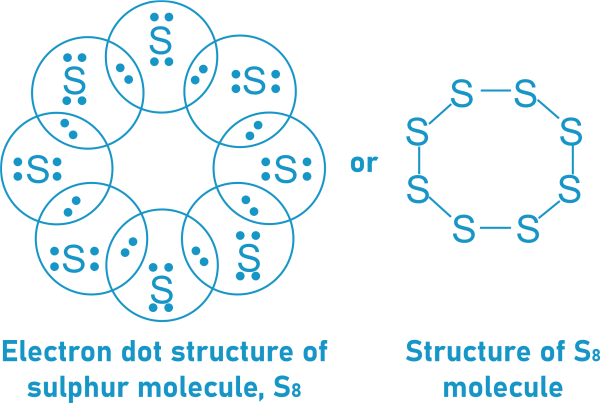
Page Number: 68-69Question 1: How many structural isomers can you draw for pentane? Answer: 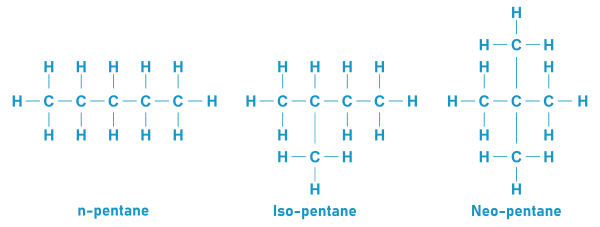
Question 2: What are the two properties of carbon which lead to the huge number of carbon compounds we see around us? Answer: Two properties of carbon which leads to the huge number of carbon compounds are:
Question 3: What will be the formula and electron dot structure of cyclopentane? Answer: The molecular formula of cyclopentane is C5H10. 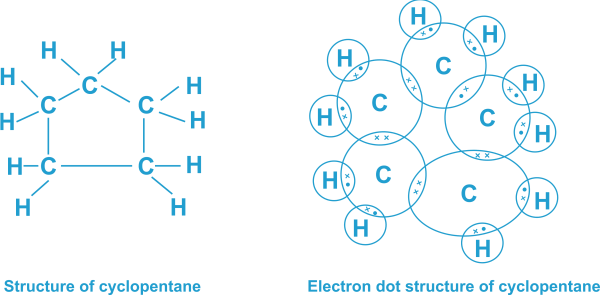
Question 4: Draw the structures for the following compounds:
Answer: i.) Ethanoic Acid - CH3COOH 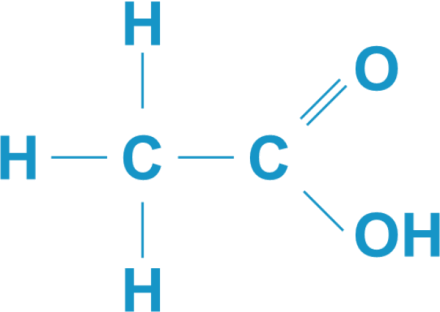
ii.) Bromopentane - C5H11Br 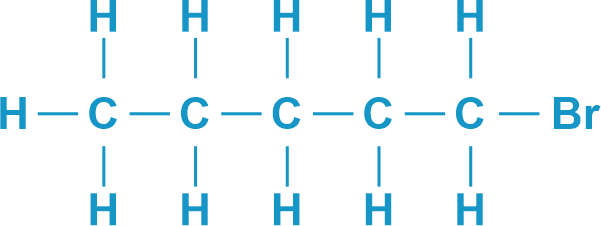
iii.) Butanone 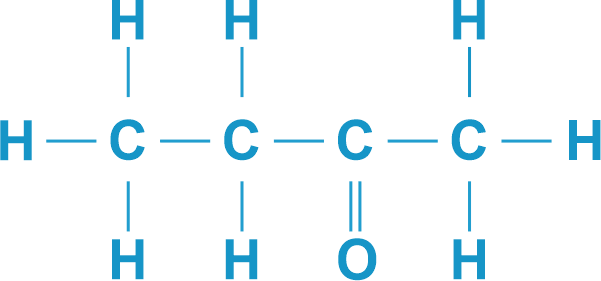
iv.) Hexanal 
Structural isomers for bromopentane: There are three structural isomers for bromopentane depending on the position of Br at carbon 1, 2, and 3. 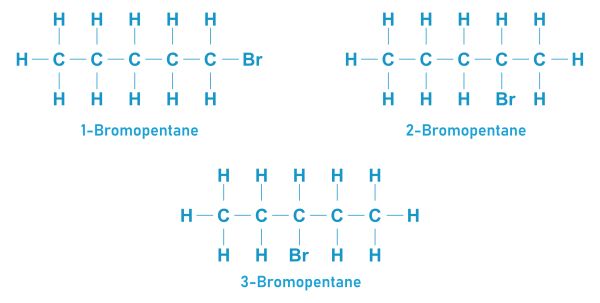
Positions 4 and 5 are the same as 2, 1. Question 5: How would you name the following compounds? 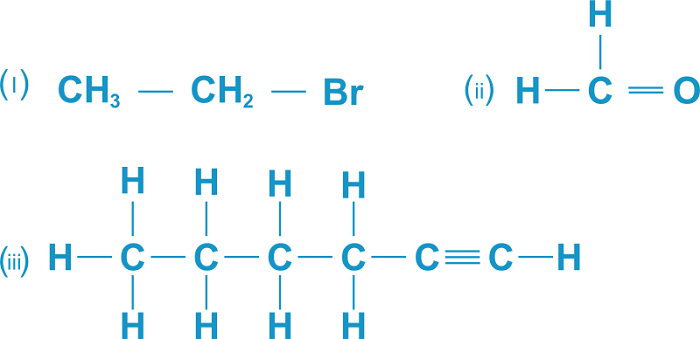
Answer:
Page Number: 71Question 1: Why is the conversion of ethanol to ethanoic acid an oxidation reaction? Answer: Because adding oxygen to the material is referred to as oxidation, the conversion of ethanol into ethanoic acid is an example of an oxidation process. Here, ethanol is made acidic by the addition of oxygen by the use of oxidising agents such as alkaline potassium permanganate or acidified potassium dichromate. 
Question 2: A mixture of oxygen and ethyne is burnt for welding. Can you tell why a mixture of ethyne and air is not used? Answer: Ethyne produces a sooty flame when it is burnt in the air due to a lack of oxygen which causes incomplete combustion. However, when ethyne is burnt with oxygen directly clean flame is produced with a temperature of about 3000°C. This occurs due to complete combustion. So this oxy-acetylene flame can be used for welding because it produces a very high temperature. However, it is not possible in a reaction of air with ethyne. Page Number: 74Question 1: How would you distinguish experimentally between an alcohol and a carboxylic acid? Answer: Differences between alcohol and carboxylic acid are:
Question 2: What are oxidising agents? Answer: Oxidizing agents are compounds that either remove hydrogen from a material or provide oxygen to another molecule. For instance, acidic K2Cr2O7 is an oxidising agent that causes ethanol to be converted (oxidised) into ethanoic acid. Page Number: 76Question 1: Would you be able to check if water is hard by using a detergent? Answer: No, as detergents may lather effectively in both soft and hard water. No insoluble calcium or magnesium salts are produced by them (scum) when the hard water's calcium and magnesium ions react with one another. Question 2: People use a variety of methods to wash clothes. Usually after adding the soap, they 'beat' the clothes on a stone, or beat it with a paddle, scrub with a brush or the mixture is agitated in a washing machine. Why is agitation necessary to get clean clothes? Answer: Because the soap micelles that capture oily or greasy particles on the surface of filthy cloth must be eliminated, agitation is required to produce clean garments. The micelles holding oily or greasy dirt are dislodged off the surface of the filthy fabric and fall into the water when the wet cloth is stirred or pounded. This cleans the dirty cloth. NCERT Solutions for Class 10 Science Chapter 4 Textbook Chapter End QuestionsQuestion 1: Ethane, with the molecular formula C2H6 has
Answer: b.) 7 covalent bonds (6 between C and Hydrogen and 1 between C and C) Question 2: Butanone is a four-carbon compound with the functional group
Answer: c.) Ketone Question 3: While cooking, if the bottom of the vessel is getting blackened on the outside, it means that
Answer: b.) The fuel is not burning completely. Question 4: Explain the nature of the covalent bond using the bond formation in CH3Cl. Answer: The covalent bond is formed by sharing of electrons so that the combining atoms complete their outermost shell. In CH3Cl : C = 6, H = 1 and Cl = 17 And their electronic configuration is C - 2,4, H - 1 and Cl - 2, 8, 7 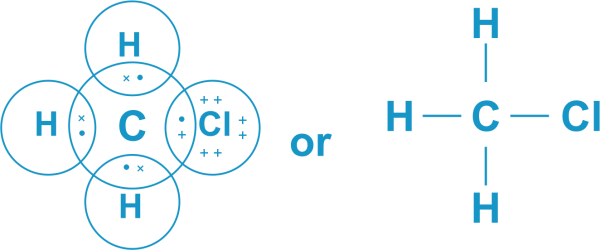
Three hydrogen atoms complete their shells by sharing three electrons with three electrons of a carbon atom. Chlorine completes its outer shell by sharing its one out of seven electrons with one electron of the carbon atom. Thus carbon atom shares all its four electrons with three hydrogen atoms and one chlorine atom and completes its outermost shell and single covalent bonds are formed in CH3Cl. Question 5: Draw the electron dot structures for
Answer: 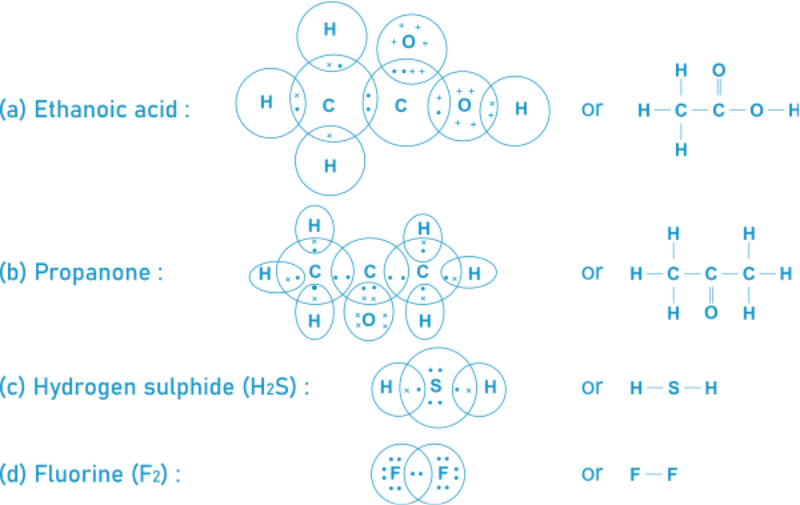
Question 6: What is a homologous series? Explain with an example. Answer: Homologous series: A homologous series is a group of organic compounds having similar structures and similar chemical properties in which the successive compounds differ by -CH2 group. Characteristics of homologous series:
For example, the general formula of the homologous series of alkanes is CnH2n+2, in which 'n' denotes the number of carbon atoms in one molecule of alkane. Following are the first five members of the homologous series of alkanes (general formula CnH2n+2).
Question 7: How can ethanol and ethanoic acid be differentiated on the basis of their physical and chemical properties? Answer: The difference on the basis of physical properties the difference between ethanol and ethanoic acid are as follows
The difference based on chemical properties
Question 8: Why does micelle formation take place when soap is added to water? Will a micelle be formed in other solvents such as ethanol also? Answer: Because soap molecules' hydrocarbon chains are hydrophobic (water-repelling) and insoluble in water, micelle production occurs when soap is introduced to water. However, soap molecules' ionic terminals are hydrophilic (water-attracting), making them soluble in water. Other solvents like ethanol, where sodium salts of fatty acids cannot dissolve, will not be able to create such micelles. Question 9: Why are carbon and its compounds used as fuels for most applications? Answer: Since carbon and its compounds produce a lot of heat per unit of weight, they are employed as fuels in the majority of applications. Question 10: Explain the formation of scum when hard water is treated with soap. Answer: Calcium and magnesium salts can be found in hard water. When calcium and magnesium combine with soap, they produce scum, an insoluble precipitate. In hard water, soap's cleaning power is reduced by scum buildup. Question 11: What change will you observe if you test soap with litmus paper (red and blue)? Answer: As a result of the soap's natural alkaline state, red litmus will turn blue. In a soap solution, blue litmus stays blue. Question 12: What is hydrogenation? What is its industrial application? Answer: The addition of hydrogen to an unsaturated hydrocarbon to obtain a saturated hydrocarbon is called hydrogenation. The process of hydrogenation takes place in the presence of nickel (Ni) or palladium (Pd) metals as a catalyst. 
Application: The process of hydrogenation has an important industrial application. It is used to prepare vegetable ghee (or vanaspati ghee) from vegetable oils. Question 13: Which of the following hydrocarbons undergo addition reactions: C2H6, C3H8, C3H6, C2H2 and CH4? Answer: Hydrocarbons that are unsaturated alone can undergo addition reactions. Because of this, addition reactions only occur in C3H6 and C2H2. Question 14: Give a test that can be used to differentiate chemically between butter and cooking oil. Answer: While cooking oil is an unsaturated carbon component, butter is a saturated carbon compound. Bromine water can be changed in colour by an unsaturated component but not by a saturated one. Therefore, using bromine water, we can chemically discriminate between butter and cooking oil. A little amount of butter and frying oil collected in separate test tubes are combined with bromine water. Bromine water loses its colour as it is cooked, indicating that it is an unsaturated substance. Butter is a saturated substance since it does not discolour bromine water. Question 15: Explain the mechanism of the cleaning action of soaps. OR Explain the cleansing action of soaps. Answer: The hydrocarbon end of the soap molecules in the micelle connects to the oil or grease particles on the surface of the unclean cloth when it is submerged in water with dissolved soap. The soap micelle uses its hydrocarbon endings to capture the greasy or oily particles. But the soap molecules' ionic ends in the micelles continue to be joined to water. The oily and greasy particles on the filthy cloth's surface that are trapped by soap micelles are released when the dirty fabric is stirred in the soap solution, making the soap water dirty but the cloth clean. Rinsing the towel many times in fresh water fully cleans it.
Next TopicClass 10 Science Chapter 5
|
 For Videos Join Our Youtube Channel: Join Now
For Videos Join Our Youtube Channel: Join Now
Feedback
- Send your Feedback to [email protected]
Help Others, Please Share









